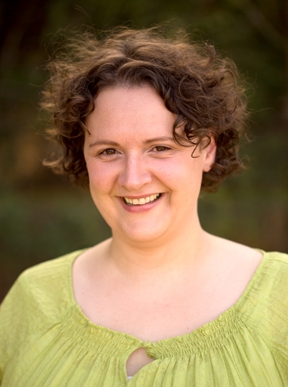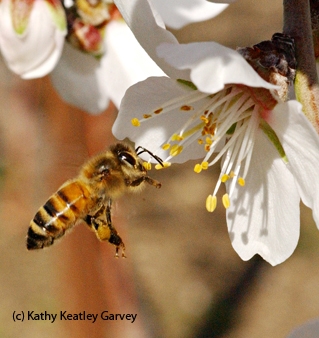
Niño, based at UC Davis, is as busy as the proverbial worker bee during a colony's spring build up as she settles into her new position involving research, education and outreach.
“California is a good place to be,” she said. “I just wish I could have brought some of that Pennsylvania rain with me to help out California's drought.”
Her lab not only aims to conduct applied research that leads to practical solutions, but to alert the state's beekeepers about new research, and develop web-based educational tools. She writes the bimonthly newsletter, “from the UC apiaries." (See her newsletter section on her website, and see the archived editions by Eric Mussen on his website). In addition, she will be serving on various advisory boards to allow “us to guide decision making and legislation based on the most up to date scientific information.”
Niño operates her field lab at Harry H. Laidlaw Jr. Honey Bee Research Facility on Bee Biology Road, west of the central campus. She also maintains a lab and office in Briggs Hall. Her aims: to conduct practical, problem-solving research projects; to support the state's beekeepers through research, extension and outreach; and to address beekeeper and industry concerns.
Niño, who studies honey bee biology, health, reproduction, pollination biology, insect ecology, evolution, genomics and chemical ecology, replaces Eric Mussen, who retired in June 30 after 38 years of service.
“Elina is a very accomplished scientist,” said Mussen. “Her research involves the reproductive processes involved in queen bee mating, including the impacts of oviduct manipulation, insemination volume and insemination substances. The induced changes include measurable behavioral, physiological and molecular alterations that occur, including differences in behavioral interactions between queens and worker bees.”
Niño has already met with many of the state's beekeepers, attended meetings of the California State Beekeepers' Association, the California Bee Breeders' Association, and the Almond Board of California, and charmed youngsters from the California School of the Blind, Fremont, who asked many questions about honey bees.
“I love meeting people,” she said. She delights in answering questions, including those from inquisitive school children.

Some don't know that all worker bees are females, that they do all the work. They are fascinated with the queen bee, which can lay as many as 2,000 eggs a day during peak season. Once a youngster, thinking about the queen bee, asked: “What happened to the king?”
Bees are in a global decline due to pesticides, parasites, pests, malnutrition and stress. Niño says most people have heard of colony collapse disorder, and many know that the average beekeeper loses approximately 30 percent of the colonies each winter due to the combined effect of various pests, pathogens, environmental toxins, and poor nutrition.
“My research and extension goals are to provide stakeholders with practical tools that better equip them to confront these challenges. My primary research focus is to characterize biological factors that regulate honey bee queen reproduction. By better understanding these factors, we can improve the honey bee breeding protocols necessary for creating and maintaining resilient honey bee stock.”
Elina Niño wasn't always so totally devoted to bees. Born and reared in Bosnia in Eastern Europe, Elina moved to the United States with plans to become a veterinarian. She obtained her bachelor's degree in animal science at Cornell University, but while there, enrolled in an entomology class on the recommendation of her advisor. “I was hooked,” she recalled.
Following her graduation from Cornell in 2003, she received her master's degree in entomology from North Carolina State University and her doctorate in entomology from Pennsylvania State University. While at Penn State, she sought to add to her applied-research expertise and gain experience in basic research. She joined the honey bee lab of Christina Grozinger, who studies the genomics of chemical communication and collaborates with researcher David Tarpy on understanding queen bee post-mating changes.
After attending her first lab meeting, “I was hooked again!” Niño recalled.
She and her fellow researchers confirmed that carbon dioxide causes queens to stop attempting mating flights and helps them start producing eggs. They also found that instrumental insemination triggers changes in Dufour's gland pheromone. Understanding the regulation of reproductive processes can lead to better management practices for improved colony productivity and health, Niño said.
Niño is now settled in Davis with her husband, Bernardo Niño, a former senior research technologist in the Grozinger lab and now a staff research associate at the Laidlaw facility; their toddler son, Sebastian; and their dog, a Doberman named Zoe. Bernardo, who managed some 40 to 50 colonies at Penn State, received his bachelor's degree in biology from St. Edward's University, Austin, Texas; and his master's degree in entomology from North Carolina State University, Raleigh.
Elina is building up her research team, which includes Bernardo; and staff research associate Billy Synk and doctoral candidate W. Cameron Jasper of the Brian Johnson lab.
“We view ourselves as the liaison between the beekeepers and other relevant growers and the scientific community,” Elina said. “We are continuing research on queen mating and reproduction, especially considering the importance of Northern California beekeepers for the queen rearing and bee breeding enterprises.”
They will expand their work to include studies “crucial for supporting honey bee health.” Current collaborate work includes examining the effects of Israeli Acute Paralysis Virus, Deformed Wing Virus and Nosema gene expression regulation and longevity in workers. Understanding the molecular mechanisms that underlie individual responses to specific honey bee pathogens, Elina said, “can lead to the implementation of appropriate beekeeping practices.”
“In the near future, we plan to contribute to the general understanding of synergistic effects of pesticides on honey bee health and collaborate on research evaluating alternative Varroa mite control.”
How would she describe herself? “Like a rock. I don't get easily disturbed. There's not a lot that fazes me. I find a way to figure out a problem and find a solution.”
Now she and her “Bee” team--that is, Bernardo and Billy--are gearing up for their inaugural queen bee rearing short-course March 28-29 at the Harry H. Laidlaw Jr. Honey Bee Research Facility. She will continue teaching these short courses to beekeepers with basic bee experience who want to learn more about rearing queens.
Another pending activity: she'll be judging the California 4-H Honey Bee Essay Contest, “Planting for Bees from Backyards and Up” (http://preservationofhoneybees.org/essays). The contest closed Feb. 20.
Meanwhile, Niño has set up her lab's website at http://elninobeelab.ucdavis.edu/; a Facebook page at https://www.facebook.com/elninolab and has obtained an easy-to-remember email in the form of "el nino": elnino@ucdavis.edu.
“California is a good place to be,” she reiterated.
An initiative to enhance competitive and sustainable food systems is part of UC Agriculture and Natural Resources Strategic Vision 2025.